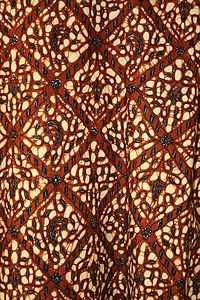Satin
 Satin used in bedding  Structure of silk satin  Portrait of a lady in satin dress (1882) by Bolesław Łaszczyński, National Museum in Warsaw. |
Satin (/ˈsætən/[1]) is a weave that typically has a glossy surface and a dull back. The satin weave is characterized by four or more cool fill or weft yarns floating over a warp yarn or vice versa, four warp yarns floating over a single weft yarn. Floats are missed interfacings, where the warp yarn lies on top of the weft in a warp-faced satin and where the weft yarn lies on top of the warp yarns in weft-faced satins. These floats explain the even sheen, as unlike in other weaves, the light reflecting is not scattered as much by the fibres, which have fewer tucks. Satin is usually a warp-faced weaving technique in which warp yarns are "floated" over weft yarns, although there are also weft-faced satins.[2] If a fabric is formed with a satin weave using filament fibres such as silk, nylon, or polyester, the corresponding fabric is termed a satin, although some definitions insist that the fabric be made from silk.[3] If the yarns used are short-staple yarns such as cotton, the fabric formed is considered a sateen.
A satin fabric tends to have a high luster due to the high number of floats on the fabric. Because of this it is used in making bed sheets. Many variations can be made of the basic satin weave including a granite weave and a check weave. Satin weaves, twill weaves, and plain weaves are the three basic types of weaving by which the majority of woven products are formed.
Satin is commonly used in apparel: satin baseball jackets, athletic shorts, women's lingerie, nightgowns, blouses, and evening gowns, but also in some men's boxer shorts, briefs, shirts and neckties. It is also used in the production of pointe shoes for use in ballet. Other uses include interior furnishing fabrics, upholstery, and bed sheets.
Origins
Originally, during the Middle Ages, satin was made of silk; consequently it was very expensive, used only by the upper classes. Satin became famous in Europe during the twelfth century. The name derives its origin from the Chinese port city of Quanzhou, whose name in (medieval) Arabic was Zayton.[4] During the latter part of the Middle Ages, it was a major shipping port of silk, using the maritime Silk Road to reach Europe.
Types of satin
- Baronet or baronette has a cotton back and a rayon or silk front, similar to georgette.[5]
- Charmeuse is a lightweight, draping satin-weave fabric with a dull reverse.[6]
- Double face(d) satin is woven with a glossy surface on both sides. It is possible for both sides to have a different pattern, albeit using the same colours.[7]
- Duchess(e) satin is a particularly luxurious, heavy, stiff satin.[6]
- Faconne is jacquard woven satin.[8]
- Farmer's satin or Venetian cloth is made from mercerised cotton.[8]
- Gattar is satin made with a silk warp and a cotton weft[9]
- Messaline is lightweight and loosely woven.[6]
- Polysatin or poly-satin is an abbreviated term for polyester satin.
- Slipper satin is stiff and medium- to heavy-weight fabric.[6]
- Sultan is a worsted fabric with a satin face.[8]
- Surf satin was a 1910s American trademark for a taffeta fabric used for swimsuits.[6]
Advantages and Disadvantages of Satin
- This weave produces smooth and soft fabrics that may give good service if they are not subjected to excessive hard wear.
- Short-float fabrics are harder than long-float fabrics.
- Long-float increases the sheen of a fabric, snag and pull if there are any protrusions or splinters on furniture.
- Satin is often chosen when calls for luxurious fabrics for formal wear style.
- It is the most suitable fabric for coat linings because its smooth surface allows coats to be slipped on and off very easily.
- In general, it sheds dirt well, but bright rayon in a long-float satin weave will often have a metallic sheen that may appear greasy after continuous wear.
- It requires more shafts in the weaving than plain or twill weaves, thereby increased in the cost of production.
See also
References
| Look up satin in Wiktionary, the free dictionary. |
- ↑ dictionary.reference.com: satin
- ↑ Emery, Irene (1994). The Primary Structures of Fabrics. Washington, D. C. Thames and Hudson. p. 137. ISBN 978-0-500-28802-3.
- ↑ Chambers Twentieth Century Dictionary, 1977.
- ↑ Tellier, Luc-Normand (2009). Urban world history: an economic and geographical perspective. Presses de l'Université du Québec. p. 221. ISBN 978-2-7605-1588-8. Retrieved 2010-11-28.
- ↑ Cumming, Valerie; Cunnington, C.W.; Cunnington, P.E. (2010). The dictionary of fashion history. Oxford: Berg. p. 231. ISBN 1847887384.
- ↑ 6.0 6.1 6.2 6.3 6.4 Shaeffer, Claire (2008). Claire Shaeffer's fabric sewing guide (2nd ed. ed.). Cincinnati, Ohio: Krause Publications. p. 238. ISBN 1440223424.
- ↑ Shaeffer, Claire (2003). Sew any fabric. Iola, WI: Krause. p. 124. ISBN 9781440222627.
- ↑ 8.0 8.1 8.2 Lewandowski, Elizabeth J. (2011). The complete costume dictionary. Lanham, Md.: Scarecrow Press, Inc. p. 309. ISBN 9780810877856.
- ↑ Maitra, K.K. (2007). Encyclopaedic dictionary of clothing and textiles. New Delhi: Mittal Publications. p. 185. ISBN 9788183242059.


.svg.png)